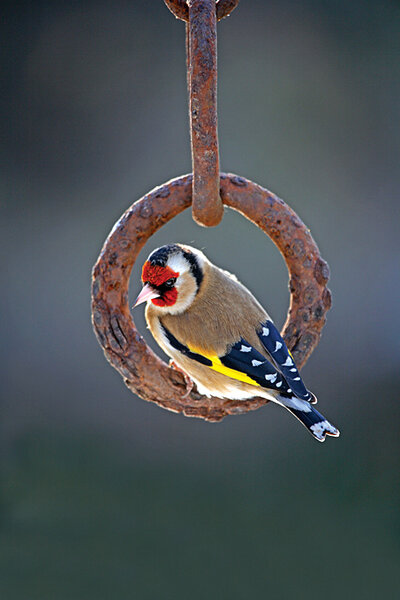Waiting for the golden ones
Loading...
I suppose it might be called "goldfinch envy." It's not terribly serious, but recently I find myself asking people if they get goldfinches in their garden.
I should explain. I live in Glasgow, Scotland. So if we were to encounter a goldfinch, it would be the irresistible European type Carduelis carduelis. This diminutive bird is a stunner colorwise. It is not just canary yellow and black like some goldfinches. Its head, starting from the front, is bright red – a brilliant scarlet mask sometimes called a "blaze" – then farther back it has white cheeks and then a black crown and side-stripes. Its black wings have a wide, bright yellow bar on them. Its back is brown, its breast is buff, and its belly white. No wonder it is a favorite of photographers, artists, and birdwatchers.
My first goldfinch-awareness was in the 1970s, country-living in Yorkshire (England). I vividly recall more than once driving to the nearest small town and seeing a sudden upflight of dozens of goldfinches from a hedgerow: a wonderful sight.
Later I learned that flocking is a goldfinch habit – they benefit from feeding gregariously – and that someone had come up with a collective noun to describe the phenomenon: They'd called it a "charm." It turns out that this appropriate term is not a recent invention. It can be found in the late 15th-century "Boke of St Albans," as one item in a long list of collective nouns for animals and birds. There it is: "a cherme of goldfynches."
"Cherme," according to later wisdom, may have referred to the song of a flock of goldfinches rather than to their fascinating appearance flying en masse. A recent field guide describes the bird's song as "sweet tinkling." Multiply that by a hundred!
But sweet tinkling birds have often been in danger. They are caught and put in cages. If strikingly colorful as well, their attractiveness to human kidnappers is that much more. Side effects of this possessive treatment, though, have not always been entirely negative. Escapees have become part of bird populations in far-flung places – Australia, New Zealand – and in parts of North America. European goldfinches might occasionally be spotted in the Western Great Lakes region, for instance.
In Britain there are an estimated 300,000 pairs of goldfinches. Enough to go round, one would imagine. But they still have the enticing appeal of rare occurrence.
They are apparently more prolific in the south of Britain than the north, and in winter many of them fly off over the Channel to warmer countries. My brother and sister-in-law live in the south, yet they have goldfinch envy like me.
I've lived in Glasgow now for 29 years, and I have a sort of feeling the goldfinches have been avoiding us. Our feeders attract coal tits, blue tits, sparrows, blackbirds, robins, magpies, and crowds of pigeons. It's like Trafalgar Square outside our kitchen window. We even had an owl perching on the bird-table roof once. We do have certain kinds of finch visit – greenfinches, chaffinches, and not long ago a very striking bullfinch. But where have all the goldfinches gone?
My southern sister-in-law is into nyjer (thistle) seed, which is – the advertising would have us believe – a goldfinch magnet. I am trying it, too – though mixed in, for economy's sake, with general bird food. The question is – how do the goldfinches get to know it's on offer? Bush telegraph?
I was visiting Didsbury in Manchester a couple of weeks ago. Didsbury happens to be the original home of what is now Britain's RSPB – Royal Society for the Protection of Birds. One of the early aims of that organization was to rescue the goldfinch. Today this bird is not considered greatly at risk.
Didsbury is about 200 miles south of Glasgow. We visited a remarkable garden there full of rare trees, shrubs, and plants. I was shown round it by its owner, Margaret Crowther, a tapestry-sculpture artist of great originality.
"Do you get goldfinches?"
"Oh yes," she said simply – as if it was a daily occurrence.
Oh – envy!
Returning home the next day, I was standing at the kitchen sink at exactly nine minutes past 2 in the afternoon – and there, sharing the feeder with a couple of brown sparrows, was a pair of goldfinches. I stared at them amazed and tried not to be seen. Two minutes later they had gone – flying south I think, up and over the house.
And – so far – that is the last of them. Unless of course they are visiting when I am not at the kitchen sink watching for them. And that's only too possible, of course.
True birdwatchers, I believe, are the most patient, immobile, one-track, dedicated, and determined people in the world. Not me, somehow. I don't think they'd claim me as quite the same species really.





